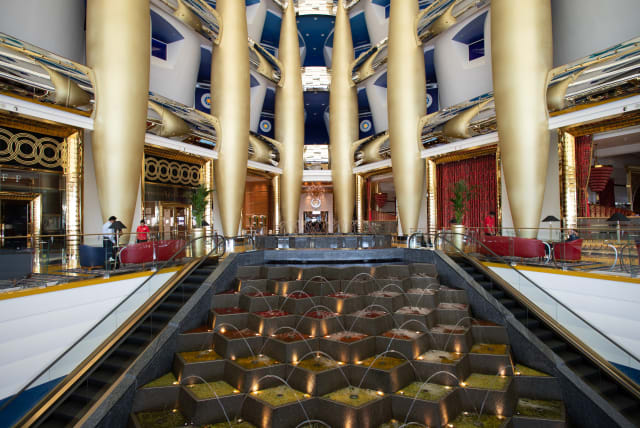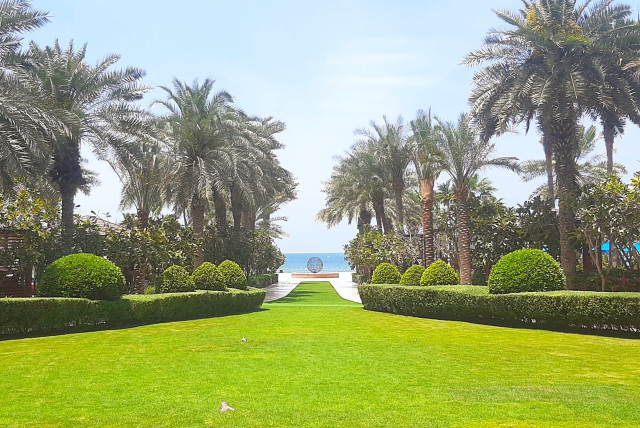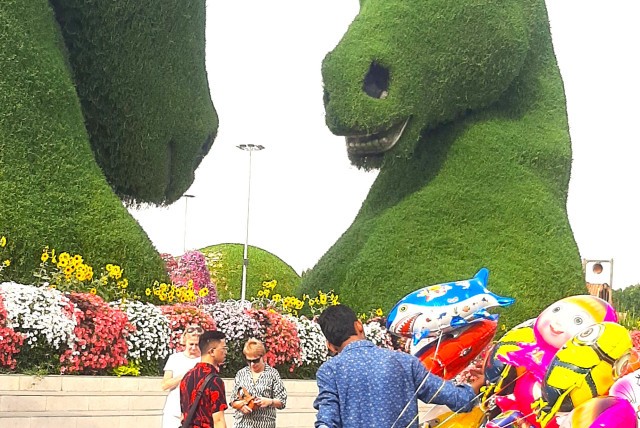Dubai shatters expectations - opinion

Stories of social inequality and potential environmental disasters are easy to find, but there is a hopeful side, if for no other reason than the difficulty of facing the alternative.
Getting to Dubai is cheap, but don’t go there to be cheap or you’ll be disappointed.
The most populous of the United Arab Emirates is about 1,300 miles from Israel. Much of the three-and-a-half hour flight spans the largest desert on Earth and its dryest place: the Rub’al-Khali, or “empty corner.” Even from the air, it appears unbearably hot and unfathomably desolate.
A careful observer can spot a few ancient signs of life, but they are a mystery from 36,000 feet, where a 6,000-year-old wall can look like a half-buried skeleton, and the skeletons can’t be seen at all.
About two-and-a-half hours out of Tel Aviv, you pass above the Persian Gulf, whose warm blue waters are teeming with fish, as they have been throughout recorded history.
On the descent, the desert starts to reveal signs of modern life. Here and there a road, straight as a razor, runs from one nowhere to another nowhere beyond the horizon. A few unadorned, functional buildings appear – signs of the region’s oil and gas industry – then an occasional group of eight or 10 unremarkable houses, surrounded by walled courtyards.
Getting closer and lower, you see white tents, hundreds of feet long, under whose shade the world’s most expensive horses train next to immaculate, air-conditioned, stables, where they are pampered like the royal pets they are.
Part metropolis, part Land of Oz
Then suddenly, there it is: Dubai, rising out of sand and nothingness, in a blare of sunlight reflected off an impenetrable mass of glass-and-steel towers. One part Metropolis, city of the future, one part Land of Oz, its tallest peak rises more than half a mile into a painfully bright sky.
The city is bordered to the north by the Gulf, its Nike-like swoosh pointing northeast to the Strait of Hormuz as the Gulf flows southeast to become the Arabian Sea.
I went to Dubai with no expectation of being startled. However, a four-day whirlwind tour shattered that notion, leaving me not only startled but vaguely uneasy.
First, the startled amazement, which begins upon arrival. Dubai International Airport carries more international traffic than any other airport in the world. But the facility, covering more than 11 square miles, is so large that it feels almost empty. That sense is increased by ceilings 162 feet overhead, supported by massive pillars that look more as if they’re covered in silver instead of polished stainless steel.
From the airport, a 12-lane highway filled with luxury cars slices through the new part of the city at the base of that impenetrable forest of glass and steel.
WE ARRIVED at the Four Seasons Resort Dubai at Jumeirah Beach, the front of which features giant, terraced planters, so that you see mostly green coming up the cobbled driveway, where far more employees than are needed open doors and smile obligingly.
A round-trip flight from Tel Aviv can be had for around $300, but the accommodations are going to cost you. (At times I thought the place should be called “Do buy!”) A room in a five-star hotel, such as the Four Seasons, can run from $700 to $2,000 per night, or more. The hotel features large, furnished balconies overlooking gardens that reach to the Gulf shores.
We were in a hurry, so there was no time to enjoy the half-acre bed or regal bathtub, in a bathroom with more amenities than there are bodily functions. So after a quick shower and shave, we headed downtown for dinner at Mina Brasserie, through whose windows you see the Burj Khalifa – the world’s tallest building – lit up against the night sky.
Travel can be exhausting, and with that oversized tub and overstuffed bed waiting, it wasn’t a late night.
Even for a non-foodie, breakfast at the Four Seasons is overwhelming. It would be physically impossible to try every offering in less than a month. While you can sit inside amid opulence, the outside setting is Eden-like, with birds flying amid a manicured jungle of exotic trees and tropical flowers. Watch out, though, as the winged buggers like to steal sugar packets from the tables.
Properly fed, we headed to Aya Universe, a crystal palace with 12 mind-bending rooms. In one, 10,000 electric flowers rise from the ground. In another, a molten-chrome tree reflects from 100 floor-to-ceiling mirrors as a purple garden changes to blue and green as you can’t find your way out the door. The next puts you in the middle of multi-colored, undulating amoeboid shapes floating all around you until up and down lose their meaning. It’s the sights, sounds and colors of a psychedelic experience without the spiritual or psychological dimensions.
AFTER REGAINING our sea legs, we headed to Al Shindagha Museum and Perfume House. There, we met Fatima. This charming woman was wrapped from head to toe in traditional veils and garments, which a quick accidental breeze revealed covered very Western jeans and T-shirt beneath.
Fatima explained the area’s ancient perfume trade and led us to a series of tubes, each of which, at the push of a button, revealed an exotic fragrance used in the mixing of traditional scents. Some, such as rose petals, are sweetly delicious. Others, such as the sweat of the Musk Ox, not so much.
Properly dazed and disoriented from the morning’s activities, we stopped for lunch at the XVA Gallery Hotel Art Restaurant. The restaurant is surrounded by old adobe walls covered with paintings that form a courtyard in which a large ficus tree and tent fabric shade the area.
Comfortably seated on benches covered with cushions and pillows, we dined on fresh, vegetarian wraps. By a cruel twist of fate, I sat facing a Victorian-era painting of a woman reclining on an overstuffed couch, so it was a struggle to stay awake.
But revived by pungent cups of coffee, we headed to the Dubai Frame, a building that resembles a giant picture frame, 500 feet tall by 300 feet wide. Up top, there’s a glass floor on which you can walk, although it’s a bit disconcerting to look beneath your feet to the ground a tenth of a mile below.
A short drive away is the Dubai Miracle Garden, appropriately named if you believe in man-made miracles. What else can you call huge terraces of brightly colored flowers and dense green shrubs in the midst of a desert? Even more amazing is the topiary: 60-foot tall sculptured shrubs in the shape of horse’s heads, elephants, airplanes and Mickey Mouse.
The scope of this article isn’t sufficient to do more than briefly mention the things we saw, each one more opulent and improbable than the last.
Dinner at the Palazzo Versace Hotel is served beside an infinity pool overlooking the Dubai Canal, where luxury yachts are docked. We worried about the poor waiter or dishwasher who might break a plate, as a single piece of Versace-designed china looked like it might cost a week’s salary.
I skipped the onsite QS Bar – although the late-night music sounded great – because of the cigarette smoke inside, and opted to wander the hotel’s hallways, admiring the detailed mosaics and tile work.
Likewise, Al Fahidi Historical Neighborhood, whose high walls and narrow alleyways deserve 1,000 words, must here be only briefly mentioned; the Arabian Tea House, another oasis where you can sit surrounded by cool, white adobe walls in another tree-shaded courtyard for a wide array of coffees and snacks; the Burj Al Arab seven-star hotel (yes, seven) and its Sahn Eddar afternoon “tea,” which is actually champagne and hand-crafted sweets created by a crew of 42 (yes, 42) pastry chefs; the Global Village, where county fair meets Dubai excess and 120 food venues compete for your attention against such things as a Ripley’s Believe it or Not Museum and a series of mock-Thai floating restaurants; the Sea Fu (sic) waterside restaurant where they entice diners by bringing slow-moving lobsters and giant prawns to your table (I opted for mackerel).
Add to that the Dubai Opera House. This miracle of design contains a fascinating, 10,000-bulb installation that ebbs and flows in brilliant electric choreography. Its giant stage is surrounded by viewing boxes and scenery that are hydraulically controlled from the floors below.
And the Dubai Mall, another “world’s largest” and which contained, to my delight, the largest bookstore I’ve ever seen, with an English-language section alone bigger than most English-only bookstores I’ve seen.
Surprising openness
IN SOME ways, Dubai is surprisingly open. Reminders of religion are everywhere, but foreigners and non-observant Muslims can drink alcohol or eat pork – even during the day in Ramadan.
The Internet is open, although pornography is blocked. But of course, no one goes to Dubai expecting a Western-style democracy or a “free press.”
A front-page story in Gulf News captured that sense by beginning: “In his capacity as the Ruler of Dubai, His Highness Shaikh Mohammad Bin Rashad Al Maktoum, Vice-President and Prime Minister of the UAE, issued a new law yesterday... ”
At the same time, the local press carried no mention of an apartment fire on the poorer side of town that same day which claimed the lives of 16 foreign laborers. Many of those laborers work in construction, a hellish job when the temperature tops 50 degrees Celsius (120°F), as it often does during the summer. Most can only afford to live crammed together in small rooms.
Nonetheless, several workers from Pakistan and Bangladesh told me they felt fortunate to be able to work in Dubai, from where they can send small stipends to aging parents back home.
Still, the apparent unsustainability of it all raises big questions for the future. The Burj Khalifa, for example, is a wonder of architectural engineering, but getting sewage from the 200th floor to the local water treatment plant hasn’t yet been solved without the daily use of 10,000-gallon tanker trucks to haul much of it away.
In a similar vein, 2010’s One Million Trees initiative ended a year later with 80% of the saplings dead.
Stories of social inequality and potential environmental disasters throughout Dubai are easy to find. However, there is a hopeful side, if for no other reason than the difficulty of facing the alternative.
After all, the United Arab Emirates has repeatedly done the impossible: It has developed cities that defy imagination; created luxury out of sand and oil; and in 2020, its leaders made peace with Israel. Remarkably, the country boasts an almost total lack of antisemitism.
So perhaps Dubai can, with continued ingenuity and drive, invent a bright future for itself.
People wonder how a Muslim-majority country could have signed a peace treaty with the Jewish state. One could ask the same of a Christian-majority or Hindu-majority nation.
The answer seems simple. While religion still permeates our world, today’s worship isn’t so much directed to Allah or Jesus or Krishna or Hashem as much as it is to the Almighty Dollar.
The writer’s trip was funded by the Dubai Board of Tourism.
Jerusalem Post Store
`; document.getElementById("linkPremium").innerHTML = cont; var divWithLink = document.getElementById("premium-link"); if (divWithLink !== null && divWithLink !== 'undefined') { divWithLink.style.border = "solid 1px #cb0f3e"; divWithLink.style.textAlign = "center"; divWithLink.style.marginBottom = "15px"; divWithLink.style.marginTop = "15px"; divWithLink.style.width = "100%"; divWithLink.style.backgroundColor = "#122952"; divWithLink.style.color = "#ffffff"; divWithLink.style.lineHeight = "1.5"; } } (function (v, i) { });



